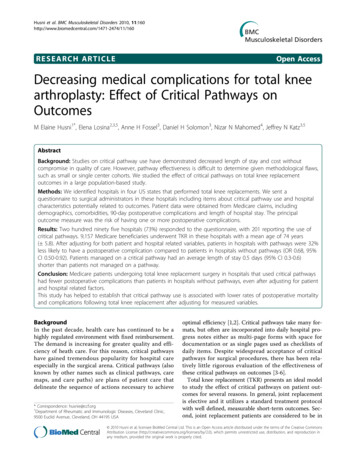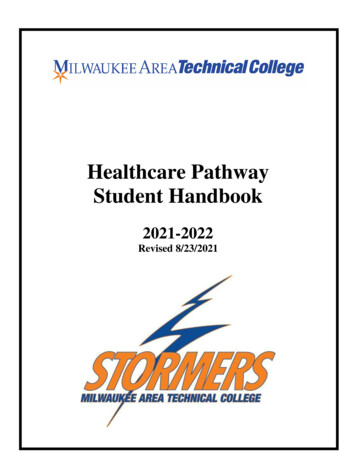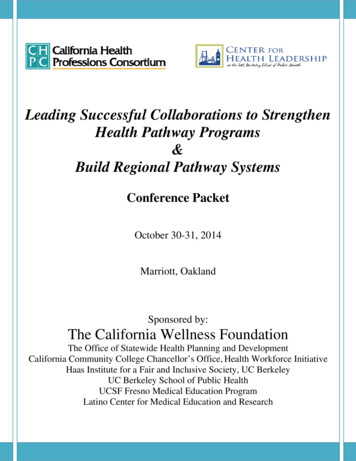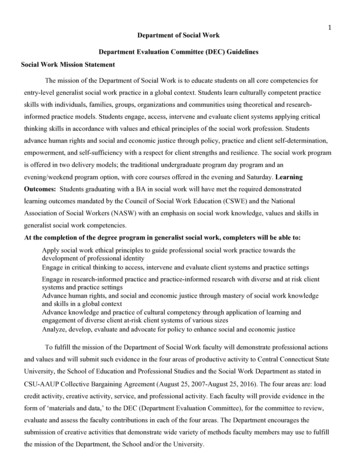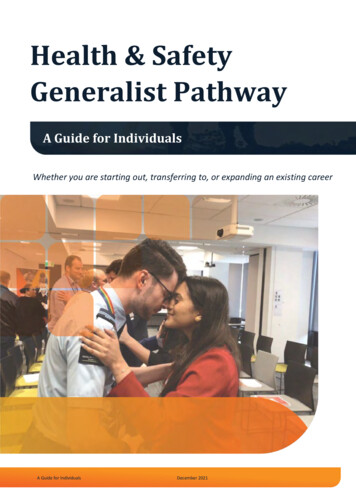
Transcription
Health & SafetyGeneralist PathwayA Guide for IndividualsWhether you are starting out, transferring to, or expanding an existing careerA Guide for IndividualsDecember 2021
ContentsIntroduction .Page 3Who is this Guide intended for and how do you use it? Page 4Health & Safety Disciplines at a Glance Page 5Common routes into the Health & Safety Profession.Page 6Why Health & Safety is a great career .Page 7 What’s on offer? Health and Safety Generalist Job FamilyMeet some Health & Safety Generalists Page 10Career Pathway Overview .Page 14Qualifications and Professional Accreditation Page 15Skills and Capabilities . .Page 16FAQ’s . .Page 19Other Sources of Information .Page 23A Guide for IndividualsDecember 2021Page 2
IntroductionThe Pathway has been developed through a partnership between the Health and Safety Associationof Zealand (HASANZ), the Government Health and Safety Lead (GHSL), in conjunction with theHealth and Safety Generalist Professional Associations, the New Zealand Institute of SafetyManagement (NZISM) and the New Zealand Safety Council (NZSC). Significant input has beenprovided by a large number of key stakeholders and individuals from across New Zealand’s publicand private sectors.HASANZ monitor and update the Pathway in conjunction with key stakeholdersHealth and Safety (H&S) professionals work to promote and protect the health, safety, andwellbeing of people at work using a mix of core technical competencies and interpersonal skills.Many people enter the H&S profession through other professions and as second careers.The H&S profession is multi-disciplinary, with many different professions working in the wider H&Sfield. This includes H&S Generalists and those in specialist fields of H&S such as Hazardous SubstanceProfessionals, Occupational Hygienists, Human Factors/Ergonomists, and Occupational HealthNurses. A brief explanation of the various disciplines available are listed in Table 1 on page 5.This guide will focus on the role, and career pathway of H&S Generalists.The International Labour Organisation (ILO) defines OccupationalHealth and Safety (OHS) as “ the science of the anticipation,recognition, evaluation, and control of hazards arising in or from theworkplace, and which could impair the health and well-being ofworkers ”.It is well known that there are substantial human and economiccosts to workers and their families, employers, and society thatresult from workplace illness and injury, and effective health andsafety management can protect against harm to workers andbusinesses.A Guide for IndividualsDecember 2021Page 3
Who is this Guideintended for andhow do you use it?This guide is intended to help you if you are: interested in starting a career in H&S, orjust getting started in H&S and want to know what lies ahead and how you can work towardsmaking the most of your choices, oralready working in a H&S role and looking to develop your career further.This guide is part of the H&S Generalist Career Pathway suite of information and has been developedwith the intent of: helping clarify what a H&S Generalist does (as compared to other H&S disciplines);helping individuals to understand some of the broad differences associated with various H&SGeneralist roles which are currently advertised; andhelping clarify the core skills and attributes needed for individuals to be successful in thosevarious roles.This guide does not replace the information provided by existing H&S professional bodies and isintended to complement information already widely available through these organisations.We suggest you read through this guidealongside the Overview of Health & SafetyGeneralist Careers in New Zealanddocument.A Guide for IndividualsDecember 2021Page 4
H&S Disciplines at a GlanceDisciplineWhat do they do?Professional BodiesH&S GeneralistsProvide general health and safety advice, planning and risk management across aworksite or organisation.New Zealand Institute of Safety Management (NZISM) https://www.nzism.org/New Zealand Safety Council (NZSC) https://www.safetycouncil.nz/Institution of Occupational Safety and Health (IOSH) ecialists in the management of safety risks from explosive, flammable, toxic orcorrosive substances being manufactured, used, stored, or transported at work.Hazardous Substances Professionals New Zealand pecialists in identifying, evaluating, and controlling risks to worker health fromphysical, chemical, and biological hazards.New Zealand Occupational Hygiene Society (NZOHS)OccupationalHealth NursesProvide advice and services to help manage the relationship between work and health,including the effects of both work on health and health on work.New Zealand Occupational Health Nurses Association (NZOHNA)Human FactorsProfessionals/Ergonomists (HFE)Use knowledge of human performance across physical, cognitive, and organisationaldomains to provide analysis and advice for the design of work equipment,environments, processes, and work systems to support healthy and productive work.Human Factors and Ergonomic Society of New Zealand (HFESNZ)OccupationalTherapistsOccupational Therapy in the workplace considers the person in the context of their liferoles, habits and routines to create a plan to optimise their function, and increase theirwork productivity, as recovery allows, in a safe and sustainable way.OccupationalHealthPhysiotherapistsWork to prevent or treat injuries suffered at work and help affected people return to orstay at work.Occupational andEnvironmentalMedicineSpecialistsDoctors who specialise in medicine related to the effects of work on health, and healthon work.OrganisationalPsychologistsExperts in human behaviour in the workplace and the impact of human behaviour onorganisational outcomes.AsbestosSpecialistsProfessionals and practitioners providing services to the asbestos rg.nz/https://www.hfesnz.org.nz/Occupational Therapy New Zealand Whakaora Ngangahau Aotearoa (OTNZWNA) https://www.otnz.co.nz/Physiotherapy New Zealand (Occupational Health Group)https://pnz.org.nz/Chapter?Action View&Chapter id 46The Australasian Faculty of Occupational and Environmental Medicine(AFOEM) of the Royal Australasian College of Physicians nmental-medicineInstitute of Organisational aculty of Asbestos Management of Australia and New Zealand.https://famanz.org/Table 1: HASANZ Understanding the professions within the Health and Safety sector nesses/
Common routes into the H&S professionThe pipeline into the H&S profession is wide and varied, some of the most common routes are shownbelow. Many people come into the H&S profession from other careers and professions with previousqualifications and experience.A Guide for IndividualsDecember 2021Page 6
Why H&S is a Great CareerEveryone has a different reason for wanting to work in H&S, and more people are entering theprofession directly from tertiary education or as a second career.The H&S profession is a highly rewarding career which is focused on the welfare of people at work.The role provides advocacy for people at work using a combination of technical skills and supportingskills. The profession is based on professional ethics and integrity and provides diverse and excitingcareer opportunities across both public and private sectors in New Zealand. H&S roles hold mana inbusinesses and are often in positions of respect and influence.Many of those working in the H&S profession have a passion for working with people, enjoy varietyand challenge, want to make a difference, and care about people. Others have been introducedthrough a different role (e.g., H&S Representative), different technical careers (e.g., science andengineering), or through professional development in business, leadership, risk, and operationsmanagement.Depending upon the sector you choose to work in, as part of your H&S role you could be out in workboots on a construction site or in a forest, or you could be working in a manufacturing site or corporate(office) environment.The H&S profession has matured over a period of years with an acknowledgement of both thetechnical, supporting, and interpersonal skills needed to be effective. Businesses are becoming moreaware of the benefits that employing a good H&S professional can bring to their organisation.International research shows that effective H&S management drives innovation and increasedbusiness performance, increases worker engagement, and drives improved organisational culture.There has been a shift from a H&S professional being “compliance-focused” to one who is the trustedadvisor, supporting the organisation to help keep people safe and healthy at work, and ultimatelycontributing towards a successful and productive business.A Guide for IndividualsDecember 2021Page 7
What’s on offer?Most people start out their H&S career as a H&S Generalist, as this enables them to use life skillsalready gained. Some may then choose to complete further formal qualifications to go into a morespecialised field.However, many people remain in a generalist role throughout their career as they enjoy the variety ofthe role (no two days are likely to be the same!), and the ability to support and influence change forthe better.Roles are available across the public and private sectors, as well as varying industry sectors. H&SGeneralists often move across different sectors to gain more experience and help them decide wherethey feel best suited to.Depending on your career aspirations or what gives you the most satisfaction, you may choose to stay“hands-on” in the role of a H&S Generalist, rather than progress up the promotion ladder to take onleadership or more strategic roles.Whatever path you choose it is likely you will have an inspiring, interesting and rewarding career aheadof you.Check out the Overview of Health & Safety Generalist Careers in New Zealand document thataccompanies this guide to give you some ideas of what the H&S Generalists job family looks like andwhat common skills and attributes can help you succeed in each role type.Use this information and combine it with the FAQs (on page 19) and what is available on the websiteswe have referred to.If you can, find yourself a role model or H&S mentor to provide you with some further ideas. If youwant more information on what a H&S mentor can provide for you, and how to go about organising amentor, contact one of the New Zealand H&S professional bodies such as the:New Zealand Institute of Safety Management (NZISM) https://www.nzism.org/New Zealand Safety Council (NZSC) https://www.safetycouncil.nz/A Guide for IndividualsDecember 2021Page 8
H&S Generalists - Job FamilyGetting Started - Common activities in these roles are likely to be:Lead - Broad activities and attributes could be: You will be an experienced strategic thinker, withexperience of change management and a strongbusiness acumen.Sitting as part of the senior management structure inthe organisation, your insight and experience are oftencalled upon to form part of business decisions andstrategic goals.You are seen as a strong leader who is able toeffectively influence across all levels of theorganisation. You are often the “go to” for initial H&S advice.You will understand how processes can and should be used inpractice and you will provide support to front-line workers andsupervisors.Coaching and mentoring a variety of stakeholders to understandwhat “good looks like” and contributing to problem solving thatimproves the workplace H&S environment and culture.Instrumental in, or part of the team, creating and delivering basicin-house H&S awareness training.Advisory - Common activities are likely to be: Senior - Broad activities and attributes could be: You are a credible source of H&S information and expertise for your organisationand play a significant part in helping management to understand the wider pictureof good H&S practice and bringing that to life.The level of “hands on” activities may be variable and will most likely focus on morecomplex and technical H&S requirements, such as critical risk management, culturechanges, assurance, and governance.If you are part of a team, you will most likely be accountable for team developmentand deliverables and providing mentoring/coaching to less experienced teammembers.You will be regularly preparing and presenting organisational H&S performanceA Guidefor IndividualsNovember 2021reportsand technicaldocumentation and may be attending senior managementmeetings to deliver and discuss contents. You may be the first point of contact for initialH&S advice.You are likely to be involved in helping people,especially front-line staff and supervisors, tounderstand what needs to be done and how touse H&S forms and documents in practice.Coaching and mentoring a variety of stakeholdersto understand what “good looks like” andcontributing to problem solving that improves theworkplace H&S environment and culture.Instrumental in, or part of the team, creating anddelivering a variety of in-house H&S awarenesstraining.Creating in-house H&S documentation.9Preparing initialPageanalyticaldata for H&Sperformance reports.
Meet some H&S GeneralistsWithin the H&S Generalist Pathway, there are four groups of jobs roles; Getting Started, Advisory,Lead and Senior. More information on these roles can be found in the Overview of H&S GeneralistCareers in New Zealand, refer to Appendix 1: H&S Generalist Job Family.Common skills and attributes exist in all four job roles. You can take a look at these in the Overview ofH&S Generalist Careers in New Zealand, refer to Appendix 2: Career Pathway Common Skills to giveyou an idea of what common technical and supporting skills and attributes are generally needed forsuccess in a particular role or position in an organisation.Check out the stories to followfrom Sudha, Peter, and Debbie tosee how they entered the H&Sprofession, and how they havedeveloped their skills across theH&S Generalist Career Pathway.A Guide for IndividualsDecember 2021Page 10
Sudha’s storySudha was a 3rd year student at Massey University studying for their Bachelor of Health Science Degreewhen they applied for a government internship through the 2016/2017 Government Health and SafetyLead Summer Intern Programme.Sudha completed the summer intern programme which they really enjoyed. The variety of health andsafety work that the intern team was involved in was fascinating and Sudha’s interest in making acareer in health and safety was established.In February 2017, after deciding to focus on health and safety as a career, Sudha went back touniversity to complete their Health Science Degree. Sudha found that after having had a ‘real world’experience to apply their Health Science theoretical knowledge during the summer internship, theywere able to approach their final year of study with a broader understanding of the contribution thatthey could make once in the workforce full time.After graduating in December 2017 Sudha decided to apply for an entry level Health and SafetyCoordinator role at a public sector agency. Sudha wanted to be able to make a difference for theircommunity and New Zealand. Sudha was successful and loved the challenge of a new environment andcollaborating with new people.After working in the coordinator role for a year Sudha was given the opportunity to be seconded intoan Emergency Response Team to help with the Whakaari/White Island tragedy in late 2019.Sudha loved the reactive, responsive, and coordinated nature of this work. When a permanent rolecame up in early 2020 Sudha applied and was successfully appointed as a Health and Safety Advisorworking at a central government agency responsible for emergency management.Sudha has since become a member of a H&S professional association, which is where they found amentor for health and safety career professional development support. Under the helpful eye of theirmentor Sudha has enrolled to complete further study in Occupational Health and Safety.A Guide for IndividualsDecember 2021Page 11
Peter’s storyPeter was working for three years as Team Leader in a Distribution & Logistics Centre inPalmerston North where he enjoyed the workplace culture, with a fantastic team. Peter hasalways had a sense of pride in the team that he leads, and he always encouraged his team tospeak up if they think something could be done better.Peter was elected as a H&S Representative for the Distribution & Logistics Centre; he joined anexisting health and safety team of one other H&S Advisor and the H&S Manager.The role of H&S Representative felt very natural to Peter, and he quickly realised that he wasalready operating, and leading his team, in a way that aligned with the organisation's healthand safety vision and values.The involvement Peter has had as part of the H&S Team, the H&S Representative training hehas received, and the interactions he has had across the wider organisation have been positiveand rewarding experiences, so much so that Peter began thinking about H&S as a full-timecareer.Fast forward three years and Peter has graduated with a Diploma in Health and Safety, whichhe completed part-time while still working in his Team Leader role. Peter is now about to starta new role as H&S Advisor for a manufacturing company.Along with the technical H&S skills that he now holds, Peter will also make use of his existingcommunication, organisational, people engagement and people leadership skills from hisprevious role.Peter joined a H&S Professional Association while studying and is now working towards theAssociation’s Practitioner Accreditation.A Guide for IndividualsDecember 2021Page 12
Debbie’s storyAfter college, Debbie went to university and graduated with a Diploma in Business Studies and a Bachelorof Business in Human Resource Management and Employment Relations.The following eight years saw Debbie working in People and Capability branches across Governmentagencies. First, as a Communications Advisor for two years, which she didn’t enjoy, so Debbie then took ayear off to complete a Graduate Diploma in Health and Safety; as she felt she was most engaged whenshe was working to find better outcomes for the people around her.Debbie re-entered the workforce and took a role as an HR Advisor, which she excelled at, and afteranother four years Debbie took a step up into a Senior HR Advisor role.Debbie enjoyed the nature of HR work, particularly helping to develop workplace cultures. During hertime as a Senior HR Advisor, Debbie developed HR training programmes, HR reporting systems andframeworks to support the demanding needs of the organisation. It was in this role that Debbie found alot of what she was doing had key elements of H&S unpinning the HR outcomes.It occurred to Debbie that her next role could be a step sideways, into a Senior H&S Advisor role.Debbie did some research and found that to excel in H&S she would need to become a Registered H&SProfessional with NZISM and/or NZSC and HASANZ.With her Graduate Diploma in Health and Safety, and as a member of the Human Resources Institute ofNew Zealand (HRNZ) for the last four years, Debbie was able to use her Continued ProfessionalDevelopment (CPD) to demonstrate her existing knowledge and experience. This enabled her to gainprofessional grading with a H&S Professional Association, which Debbie would need to become registeredwith HASANZ.Fast forward eight years, Debbie is now a General Manager of Health, Safety and Wellbeing for a largeGovernment agency. Debbie is setting the direction for H&S in this agency and is leading a team of H&Sprofessionals to create better health, safety and wellbeing outcomes for the agency and its people.A Guide for IndividualsDecember 2021Page 13
Career Pathway OverviewThe Career Pathway for a H&S Generalist is not necessarily linear, and an individual could easilyprogress depending upon the size of the organisation and the industry sector they are working in.The table below is intended to provide a snapshot of some core requirements, including priorexperience, qualifications, and professional accreditation.Take a look at the other documents that make up this suite of information, and the various websites,to help get a broader view of what is on offer.Is a H&S qualificationand accreditationrequired?Ideal entry requirementsBrief overview of roleexpectationsGettingStarted Often first pointof contact forH&S information.May be custodianof H&S systems,such asdocumentation,reportingdatabase etc. The “go to” for H&Sadvice on key matters.A “hands-on”practitioner, familiarwith how processescan/should work inpractice.LeadSeniorAdvisory Experienced H&Sprofessional capable ofworking across wholeof the organisation.Acts as lead and/or “inhouse” coach for lessexperienced H&S teammembers. Prior H&S Prior practical experience Generally, 2-5 years’experience possiblyin H&S or associatedexperience held previousgained as a H&S Codiscipline (ideally 1-2H&S positions at advisoryordinator, throughyears).level, ORformal study or with Holding or working Senior roles in anotherH&S responsibilitiestowards formal H&Sdiscipline.as part of priorqualification. Expected to hold orroles. A proven track record ofworking towardssuccess.completion of a tertiaryH&S qualification thatwill support professionalH&S accreditation. A proven track record ofsuccess. The organisations experton all H&S matters.Sets Strategic H&Sdirection and influencesat Senior Managementand Board level. More than five years’experience, including inprior senior positions(ideally from a H&Sdiscipline), attained acrossa variety of organisationsand industry sectors. Experience managingteams and working atExecutive or Senior level. Expected to hold H&SProfessional Accreditationand tertiary qualifications. A proven track record ofsuccess. Desirable but not Yes (noting that the more senior the position, the more essential a qualification andessential. See theaccreditation should be to the individual and organisation).table in the nextpage for examplesRefer to the relevant H&S professional body websites for more information:of qualifications w.safetycouncil.nz/Even if you chose to work as a H&S Generalist, you can still progress to become a “specialist”, either by focusingon a specific H&S area such as critical risk management or wellbeing, or by gaining specific qualifications andexperience.Whatever pathway you choose, the most important thing is that you ensure that you work within your area ofA Guide for Individuals2021 when you need them.Page 14expertiseand competency and reach out to the otherDecemberdisciplines
Qualifications and Professional AccreditationAs with other professions, the importance of formal qualifications, applied experience andprofessional accreditation is required. It is desirable that those working as H&S Generalists shouldhold or be working towards attaining appropriate recognised H&S qualifications, and professionalassociation accreditation.The table below provides a brief overview of what this looks like in New Zealand, across the fourareas of H&S Generalist roles: Getting Started, Advisory, Senior and Lead.Job FamilyH&S QualificationNZISM AccreditationNZSC AccreditationGettingStartedAdvisoryWorking towardsNZQA Level 4NZQA Level 4NZISMPractitionerNZISM AffiliateNZSC MemberNOTE: RequiresLevel 4 certificatein OHSNZSC RegisteredSafetyProfessional (RSP)NOTE: RequiresLevel 6 DiplomaSeniorLeadNZQA Level 6DiplomaNZQA Level 7 Degree or HigherNZISMProfessional andHASANZRegisteredNZISM CertifiedProfessional andHASANZ RegisteredNZSC RegisteredSafetyProfessional (RSP)& HASANZRegisteredNZSC RegisteredSafety Professional(RSP) & HASANZRegisteredFurther information on recognised qualifications and accreditation pathways aligned to the two NewZealand professional associations can be found at https://www.nzism.org/ andhttps://www.safetycouncil.nz/.Points of note: Industry sectors also set their own preferred technical and supporting skills and capabilities; thisis common in both the public and private sectors.It is important for organisations (and those working in H&S) to recognise that a H&S Generalistmay need to enlist the assistance of one of the other H&S disciplines so that expert advice andassistance can be provided.A Guide for IndividualsDecember 2021Page 15
Skills and CapabilitiesSuccessful H&S Generalists will often hold a variety of attributes that include both technical H&S andsupporting skills. Organisations and industry sectors (especially those of a highly hazardous orspecialist nature) may require specific H&S competencies and skills.Using the Career Pathway Common Skills (refer to Appendix 2 of the Overview of H&S GeneralistCareers in New Zealand document), each professional body and their respective accreditationprogrammes, including other international accreditation bodies that are recognised in New Zealand,have been mapped to reference the skills and capabilities that each professional accreditation requires.A Guide for IndividualsDecember 2021Page 16
H&S Generalists Professional Accreditation - Technical SkillsH&S Legislation knowledgeand its application inpracticeRisk management(methodology andapplication)INSHPOProfessional & Ethical PracticeTechnical SkillsCareer PathwayKnowledge managementNZISMLaw, regulation and societal contextNZSCDetermine the legal framework of OHS inthe workplaceProvide advice and make judgments onOHS compliance, legislation, andstandardsOHS Risk management processesHazard and riskHazard and risk ControlAccess sources of information and data toidentify hazards and provide adviceControl risk associated with hazardsMonitor and review risk managementprocesses, technical information, andcurrent/future industry practiceIdentify hazards arising from the use ofplant, equipment, and associated systemsof workH&S Management systemsdevelopmentSystems managementImplementation of H&Sprocess and documentedsystems into practiceH&S Performance analysisand ReportingSafety managementOHS Information managementLead and support the development andapplication of systems, policies andprocedures, and collection of workplaceinformation, data, and recordsCommunication, engagement andinfluenceRisk assessment and decision making onriskManagement of OHS information andData–application into practiceMeasuring and evaluatingperformanceMonitoring, evaluating, and validatingcontrolsManagement of OHS information anddata-analyse, identifying trends andmitigation plans. Communication of OHSinformation to stakeholdersStatistics and qualitative analysisA Guide for IndividualsDecember 2021Page 17
H&S Generalists Professional Accreditation – Supporting SkillsSupporting SkillsCareer PathwayINSHPONZISMNZSCCommunication andinfluencing (includingthrough coaching andmentoring)Communication, engagement and influenceCommunication and consultationChange managementDesign and develop OHS participativearrangements and processes and facilitatecoaching and mentoringBusiness acumenBusiness and organisationalOrganisation’s business imperativesLead/support systematic and prioritisedapproach to managing OHS and provideguidance and advice to key stakeholders,influencing safety and business outcomesTraining and facilitationCommunication, engagement and influenceProfessional role and functioningSafety and health managementLead and facilitate training and skillsdevelopment, ensuring workercompetency in areas of OHSAssurance and verificationMeasuring and evaluating performanceSafety and health managementReviewing safety - lead, plan andimplement organisation audit, review andmonitoring activitiesStrategic planning (incl.preparation of annual workplans/targets and goals)Strategic planningStrategic and operational planningDevelop and implement organisationalstrategies and plans to improve safetypractices and outcomesProject managementCommunication, engagement and influenceProject managementIdentify and recommend controls forhazards associated with projects andcontinued safe use of plant andequipment throughout lifecycleCultural awarenessOrganisational culture and impact on OHSOrganisational cultureCulture - diversity and the changing faceof the NZ workplaceProblem-solvingOrganisational culture and impact on OHScommunication, engagement and influenceSystemsIndividual psychologySocial psychologyFacilitate and participate in thedevelopment of strategies to resolveissues related to OHSA Guide for IndividualsDecember 2021Page 18
Frequently Asked QuestionsAfter reading this guide you may have some further questions. Read on for our FAQs.QuestionAnswer / GuidanceWhat experience orskills do I need to have,or need to focus onachieving, to get intoH&S?The experience, skills, and attributes will vary from role to role,from each organisation and across industry sectors.Do I have to have aformal H&Squalification before Ican get a H&S role?In many organisations, if you start in a coordinator or graduate role,a formal H&S qualification may not be necessary.To give you a broad understanding of what may be needed for aparticular role, check out Appendix 2 in the Overview of Health &Safety Generalist Careers in New Zealand document.Like many other professions, a formal qualification is required toprogress your career. As you progress your H&S career, and take onmor
helping clarify what a H&S Generalist does (as compared to other H&S disciplines); helping individuals to understand some of the broad differences associated with various H&S Generalist roles which are currently advertised; and helping clarify the core skills and attributes needed for individuals to be successful in those



